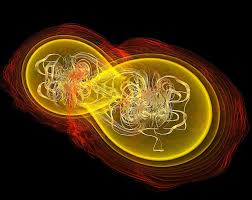My activity spans over three main thematic areas of research :
- nuclear-physics properties of neutron stars (NS), and their impact on the observability of NSs ;
- properties of dense QCD matter in NSs and phase transitions taking place in their interiors ;
- gravitational-wave emission from single NSs and their impact on constraining their properties.
 The most important contribution I have given in this field is the derivation, in the hadronic sector, of a fully microscopic equation of state in the framework of a microscopic quantum many-body theory, the Brueckner-Hartree-Fock approach, with the explicit inclusion of hyperonic degrees of freedom. A complete set of calculations of the equation of state is now available in tabular form, both at zero and finite temperature. Those are widely used by other scientific groups as input for the numerical simulations of, e.g., compact stars merging and core-collapse supernova explosions.
The most important contribution I have given in this field is the derivation, in the hadronic sector, of a fully microscopic equation of state in the framework of a microscopic quantum many-body theory, the Brueckner-Hartree-Fock approach, with the explicit inclusion of hyperonic degrees of freedom. A complete set of calculations of the equation of state is now available in tabular form, both at zero and finite temperature. Those are widely used by other scientific groups as input for the numerical simulations of, e.g., compact stars merging and core-collapse supernova explosions.
The investigation of the high density and low temperature region of the phase- boundary between hadronic matter and the quark-gluon plasma is currently a strongly debated problem in the theoretical community, and I have given in this field an essential contribution. Indeed, I have shown that the hadron-quark phase transition in NSs limits the value of the maximum mass to about 2.0 solar masses, thus predicting that the observation of a more massive NS gives direct access to the quark matter EoS which has to be strongly repulsive.
 This has produced observational limits, which are complementary with those from nuclear structure and heavy-ion collisions. The theoretical activities illustrated above are the main themes of the European Action MPNS COST Action CA16214, named PHAROS, “The multi-messenger physics and astrophysics of neutron stars”, which addresses nuclear/particle physics aspects, observations, and astrophysics ,.
This has produced observational limits, which are complementary with those from nuclear structure and heavy-ion collisions. The theoretical activities illustrated above are the main themes of the European Action MPNS COST Action CA16214, named PHAROS, “The multi-messenger physics and astrophysics of neutron stars”, which addresses nuclear/particle physics aspects, observations, and astrophysics ,.